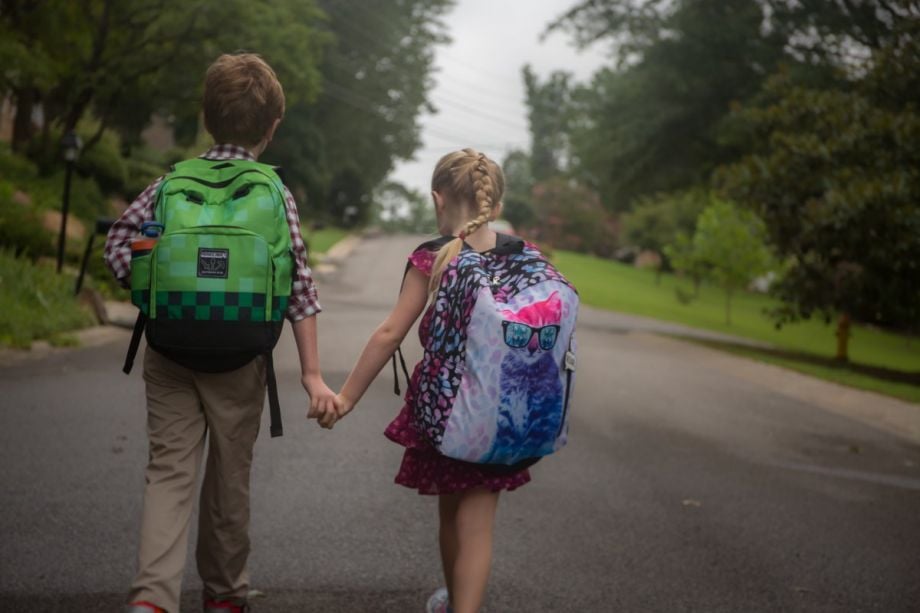As back-to-school season starts up again, it might seem like little has changed about the journey to and from school every day. But here’s a striking fact: the percentage of students walking or biking to school has decreased dramatically over time, from 42 percent in 1969 to only 10 percent in 2017. Rates of walking and biking fell dramatically over decades, then leveled off around 2000. Getting more students walking and biking to school isn’t just about nostalgia for the days when students walked 15 miles uphill to school — both ways. It could have widespread benefits for students and for communities.
At an individual level, walking and biking can boost students’ health, physical activity, and even their concentration in school. If more students walked or biked to school, there could also be meaningful benefits in terms of environmental health and student safety. The more students who walk or bike, the less cars on the road around schools, which could minimize safety hazards and decrease air pollution.
The problem is that right now, too many families don’t perceive walking or biking as safe, and unfriendly infrastructure in many communities does little to dissuade them. The infrastructure investments in our cities and states have prioritized cars and traffic reduction over pedestrians and cyclists. Even among students who live less than a mile from school, walking and biking has decreased dramatically in favor of cars.
This creates a vicious cycle: the fewer students who walk or bike, the less safe and normal it feels to do so. And investments in student-friendly streets seem less urgent if most people opt to drive. But if more students walked to school, it could actually increase the safety of walking and biking and demonstrate demand for student-friendly infrastructure investments. That would also mean fewer cars on the road and more visible reminders for drivers to be safe. The same principles apply for adults walking and biking to their jobs — but students are much more likely to live close to school, and the safety stakes are even higher.
Walking and biking could also have environmental benefits for communities. School transportation from school buses and private vehicles results in millions of tons of greenhouse gases per year, which contribute to climate change, and exposes children in vehicles or on the street to harmful pollutants. The impact of this exposure is significant: A recent study showed that equipping buses with cleaner fuel technology improved respiratory health and attendance rates and test scores.
And encouraging walking and biking is an equity issue. Low-income, black, and Hispanic students are three times more likely to walk or bike to school than their peers, so making walking and biking safer and more supported could have particular benefits for these students. This is due to a combination of factors, including access to a vehicle and a driver, and higher likelihood of living in denser neighborhoods close to school.
In order for more students and families to choose active forms of school transportation safely and confidently, they need support and dedicated infrastructure investments in and around schools. There are a few relatively low-cost solutions communities can implement to get started. One is for parents or schools to organize a “walking school bus” for students from the same neighborhood to get to school together. In these models a volunteer or an aide accompanies students along a consistent walking route, picking up students along the way at predetermined stops. Another would be for schools and districts to implement targeted supervision along popular walking or biking routes. In Chicago, for example, “Safe Passage” workers from community based organizations are posted along designated walking routes to and from participating schools to engage with students and families and monitor student safety. Crime during school hours along these supervised routes has gone down 32 percent since 2012.
But more comprehensive solutions involve wider infrastructure changes like protected bike lanes, traffic-calming measures, and curb extensions to make streets safer for pedestrians and cyclists of all ages. Success can start at the school level, but local and state governments need to partner in this effort to really shift the walking and biking environment for students. Federal programs, like the Transportation Alternatives Program and Safe Routes to School, can cover part of the cost of comprehensive walking and biking programs, and the Safe Routes Partnership provides models, guidance, and support for communities looking to advance their Safe Routes to School approach. Across various communities, Safe Routes to School programs have been associated with higher rates of walking and biking, and lower rates of child injury.
Portland, Oregon is an exemplar, with the share of students walking and biking on track to exceed 50 percent by 2025, up from about 30 percent in 2006. Portland’s multipronged efforts go beyond the school district, including a voter-approved gas tax to support safe routes to school, new traffic engineering plans and family safety education around select schools, and investments in bikeways and pedestrian-friendly streets across the city.
It will be up to local communities invest in student-oriented streets, turn around trends, and help more families to choose a walking or biking journey to school. They should remember that when more students walk or bike to school, the environment and student safety could both reap rewards.

Bonnie O'Keefe is an associate partner on the policy and evaluation team at Bellwether Education Partners, a national nonprofit with a mission to dramatically change education and life outcomes for underserved children. Bonnie is the co-author of three recent policy briefs on student transportation. Prior to Bellwether, Bonnie worked for a state education agency and a local education advocacy organization.
















